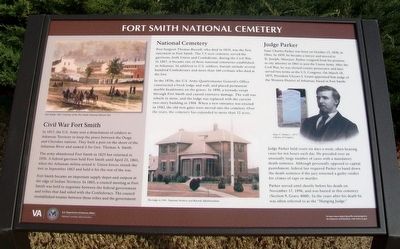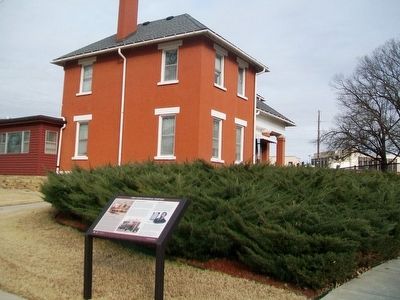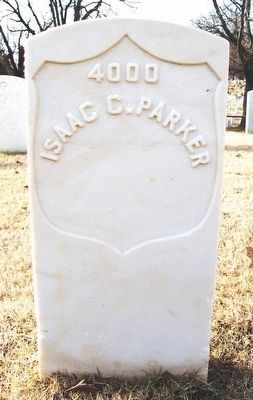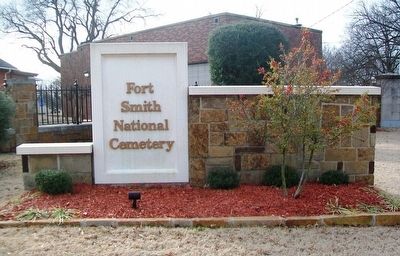Fort Smith National Cemetery
Civil War Fort Smith
In 1817, the U.S. Army sent a detachment of soldiers to Arkansas Territory to keep the peace between the Osage and Cherokee nations. They built a post on the shore of the Arkansas River and named it for Gen. Thomas A. Smith.
The army abandoned Fort Smith in 1825 but returned in 1836. A federal garrison held Fort Smith until April 23, 1861, when the Arkansas militia seized it. Union forces retook the fort in September 1863 and held it for the rest of the war.
Fort Smith became an important supply depot and outpost at the edge of Indian Territory. In 1865, a council meeting at Fort Smith was held to negotiate between the federal government and tribes that had sided with the Confederacy. The council reestablished treaties between those tribes and the government.
[Photo caption reads]
Fort Smith, 1865. Courtesy of the Fort Smith National Historic Site.
National Cemetery
Post Surgeon Thomas Russell, who died in 1819, was the first interment at Fort Smith. The 5.5-acre cemetery served the garrisons, both Union and Confederate, during the Civil War. In 1867, it became one of three national cemeteries established in Arkansas. In addition to U.S. soldiers, burials include several hundred Confederates and more than 160 civilians who died at the fort.
In
the 1870s, the U.S. Army Quartermaster General's office constructed a brick lodge and wall, and placed permanent marble headstones on the graves. In 1898, a tornado swept through Fort Smith and caused extensive damage. The wall was rebuilt in stone, and the lodge was replaced with the current two-story building in 1904. When a new entrance was erected in 1942, the old iron gates were moved into the cemetery. Over the years, the cemetery has expanded to more than 32 acres.
[Photo caption reads]
The lodge in 1941. National Archives and Records Administration.
Judge Parker
Isaac Charles Parker was born on October 15, 1838, in Ohio. In 1859, he became a lawyer and moved to St. Joseph, Missouri. Parker resigned from his position as city attorney in 1861 to join the Union Army. After the Civil War, he was elected county prosecutor and later served two terms in the U.S. Congress. On March 18, 1875, President Ulysses S. Grant appointed him judge of the Western District of Arkansas, based in Fort Smith.
Judge Parker held court six days a week, often hearing cases for ten hours each day. He presided over an unusually large number of cases with a mandatory death sentence. Although personally opposed to capital punishment, federal law required Parker to hand down the death sentence if the jury returned a guilty verdict for crimes of rape or
Parker served until shortly before his death on November 17, 1896, and was buried in this cemetery (Section 9, Grave 4000). In the years after his death he was often referred to as the "Hanging Judge."
[Photo caption reads]
Isaac C. Parker, c. 1875. Library of Congress.
Erected by Department of Veterans Affairs National Cemetery Administration.
Topics and series. This historical marker is listed in these topic lists: Cemeteries & Burial Sites • Patriots & Patriotism • War, US Civil. In addition, it is included in the National Cemeteries series list. A significant historical year for this entry is 1817.
Location. 35° 23.062′ N, 94° 25.704′ W. Marker is in Fort Smith, Arkansas, in Sebastian County. Marker is along the path leading to the cemetery office, near the entrance circle. Touch for map. Marker is at or near this postal address: 522 Garland Avenue, Fort Smith AR 72901, United States of America. Touch for directions.
Other nearby markers. At least 8 other markers are within walking distance of this marker. Confederate Burials in the National Cemetery (a few steps from this marker); A National Cemetery System (a few steps from this marker); Address by President Lincoln (within shouting distance of this marker); Veterans Memorial Carillon (within shouting distance of this marker); Veterans Memorial
Also see . . .
1. Fort Smith National Cemetery. U.S. Department of Veteran Affairs entry (Submitted on January 22, 2016, by William Fischer, Jr. of Scranton, Pennsylvania.)
2. Fort Smith National Historic Site. National park Service entry (Submitted on January 22, 2016, by William Fischer, Jr. of Scranton, Pennsylvania.)
Credits. This page was last revised on January 4, 2021. It was originally submitted on January 22, 2016, by William Fischer, Jr. of Scranton, Pennsylvania. This page has been viewed 465 times since then and 37 times this year. Photos: 1, 2, 3. submitted on January 22, 2016, by William Fischer, Jr. of Scranton, Pennsylvania. 4. submitted on January 23, 2016, by William Fischer, Jr. of Scranton, Pennsylvania.



